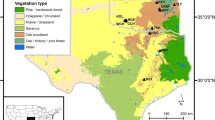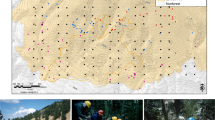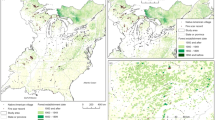Abstract
Determination of the direct causal factors controlling wildfires is key to understanding wildfire–vegetation–climate dynamics in a changing climate and for developing sustainable management strategies for biodiversity conservation and maintenance of long-term forest productivity. In this study, we sought to understand how the fire frequency of a large mixedwood forest in the central boreal shield varies as a result of temporal and spatial factors. We reconstructed the fire history of an 11,600-km2 area located in the northwestern boreal forest of Ontario, using archival data of large fires occurring since 1921 and dendrochronological dating for fires prior to 1921. The fire cycle decreased from 295 years for the period of 1820–1920 to approximately 100 years for the period of 1921–2008. Spatially, fire frequency increased with latitude, attributable to higher human activities that have increased fragmentation and fire suppression in the southern portion of the study area. Fire frequency also increased with distance to waterbodies, and was higher on Podzols that were strongly correlated with moderate drainage and coniferous vegetation. The temporal increase of fire frequency in the central region, unlike western and eastern boreal forests where fire frequency has decreased, may be a result of increased warm and dry conditions associated with climate change in central North America, suggesting that the response of wildfire to global climate change may be regionally individualistic. The significant spatial factors we found in this study are in agreement with other wildfire studies, indicating the commonality of the influences by physiographic features and human activities on regional fire regimes across the boreal forest. Overall, wildfire in the central boreal shield is more frequent than that in the wetter eastern boreal region and less frequent than that in the drier western boreal region, confirming a climatic top-down control on the fire activities of the entire North American boreal forest.



Similar content being viewed by others
References
Baldwin DJB, Desloges JR, Band LE. 2001. Physical geography of Ontario. In: Perera A, Euler D, Thompson I, Eds. Ecology of a managed terrestrial landscape: patterns and processes of forest landscapes in Ontario. Vancouver: UBC Press.
Bergeron Y. 1991. The influence of island and mainland lakeshore landscapes on boreal forest-fire regimes. Ecology 72(6):1980–92.
Bergeron Y, Dansereau PR. 1993. Predicting the composition of Canadian southern boreal forest in different fire cycles. J Veg Sci 4(6):827–32.
Bergeron Y, Leduc A, Harvey BD, Gauthier S. 2002. Natural fire regime: a guide for sustainable management of the Canadian boreal forest. Silva Fenn 36(1):81–95.
Bergeron Y, Flannigan M, Gauthier S, Leduc A, Lefort P. 2004a. Past, current and future fire frequency in the Canadian boreal forest: implications for sustainable forest management. Ambio 33:356–60.
Bergeron Y, Gauthier S, Flannigan M, Kafka V. 2004b. Fire regimes at the transition between mixedwood and coniferous boreal forest in Northwestern Quebec. Ecology 85(7):1916–32.
Bergeron Y, Cyr D, Drever CR, Flannigan M, Gauthier S, Kneeshaw D, Lauzon E, Leduc A, Le Goff O, Lesieur D, Logan K. 2006. Past, current, and future fire frequencies in Quebec’s commercial forests: implications for the cumulative effects of harvesting and fire on age-class structure and natural disturbance-based management. Can J For Res 36(11):2737–44.
Beverly JL, Martell DL. 2005. Characterizing extreme fire and weather events in the Boreal Shield ecozone of Ontario. Agric For Meteorol 133(1–4):5–16.
Bond-Lamberty B, Peckham SD, Ahl DE, Gower ST. 2007. Fire as the dominant driver of central Canadian boreal forest carbon balance. Nature 450(7166):89.
Brassard BW, Chen HYH. 2008. Effects of forest type and disturbance on diversity of coarse woody debris in boreal forest. Ecosystems 11(7):1078–90.
Brassard BW, Chen HYH, Wang JR, Duinker PN. 2008. Effects of time since stand-replacing fire and overstory composition on live-tree structural diversity in the boreal forest of central Canada. Can J For Res 38(1):52–62.
Chapin FS, McGuire AD, Randerson J, Pielke R, Baldocchi D, Hobbie SE, Roulet N, Eugster W, Kasischke E, Rastetter EB, Zimov SA, Running SW. 2000. Arctic and boreal ecosystems of western North America as components of the climate system. Glob Chang Biol 6:211–23.
Chen HYH, Popadiouk RV. 2002. Dynamics of North American boreal mixedwoods. Environ Rev 10:137–66.
Chen HYH, Vasiliauskas S, Kayahara GJ, Ilisson T. 2009. Wildfire promotes broadleaves and species mixture in boreal forest. For Ecol Manage 257:343–50.
Clark JS. 1988. Effect of climate change on fire regimes in northwestern Minnesota. Nature 334(6179):233–5.
Clark JS. 1990. Fire and climate change during the last 750 yr in northwestern Minnesota. Ecol Monogr 60(2):135–59.
Clark JS, Royall PD. 1996. Local and regional sediment charcoal evidence for fire regimes in presettlement north-eastern North America. J Ecol 84(3):365–82.
Connell JH. 1978. Diversity in tropical rain forests and coral reefs—high diversity of trees and corals is maintained only in a non-equilibrium state. Science 199(4335):1302–10.
Cox DR. 1972. Regression models and life tables (with discussion). J R Stat Soc Series B 34:187–220.
Cyr D, Bergeron Y, Gauthier S, Larouche A. 2005. Are the old-growth forests of the Clay Belt part of a fire-regulated mosaic? Can J For Res 35(1):65–73.
Cyr D, Gauthier S, Bergeron Y. 2007. Scale-dependent determinants of heterogeneity in fire frequency in a coniferous boreal forest of eastern Canada. Landsc Ecol 22(9):1325–39.
Drever CR, Messier C, Bergeron Y, Doyon F. 2006. Fire and canopy species composition in the Great Lakes-St. Lawrence forest of Temiscamingue, Quebec. For Ecol Manage 231(1–3):27–37.
Ecoregions Working Group. 1989. Ecoclimatic regions of Canada, first approximation. Ecological Land Classification Series, No. 23. Ottawa, ON: Sustainable Development Branch, Canadian Wildlife Service, Conservation and Protection, Environment Canada.
Flanagan PW, Vancleve K. 1983. Nutrient cycling in relation to decomposition and organic-matter quality in Taiga ecosystems. Can J For Res 13(5):795–817.
Foster DR. 1983. The history and pattern of fire in the boreal forest of southeastern Labrador. Can J Bot 61(9):2459–71.
Gillett NP, Weaver AJ, Zwiers FW, Flannigan MD. 2004. Detecting the effect of climate change on Canadian forest fires. Geophys Res Lett 31(18):L18211. doi:10.1029/2004GL020876.
Girardin MP, Tardif JC, Flannigan MD, Bergeron Y. 2005. Synoptic-scale atmospheric circulation and boreal Canada summer drought variability of the past three centuries. J Clim 19:1922–47.
Girardin MP, Tardiff JC, Flannigan MD, Bergeron Y. 2006a. Forest fire-conducive drought variability in the southern Canadian boreal forest and associated climatology inferred from tree rings. Can Water Resour J 31(4):275–96.
Girardin MP, Bergeron Y, Tardif JC, Gauthier S, Flannigan MD, Mudelsee M. 2006b. A 229-year dendroclimatic-inferred record of forest fire activity for the Boreal Shield of Canada. Int J Wildland Fire 15(3):375–88.
Girardin MP, Ali AA, Carcaillet C, Mudelsee M, Drobyshev I, Hely C, Bergeron Y. 2009. Heterogeneous response of circumboreal wildfire risk to climate change since the early 1900s. Glob Chang Biol 15(11):2751–69.
Hart SA, Chen HYH. 2006. Understory vegetation dynamics of North American boreal forests. Crit Rev Plant Sci 25(4):381–97.
Hart SA, Chen HYH. 2008. Fire, logging, and overstory affect understory abundance, diversity, and composition in boreal forest. Ecol Monogr 78(1):123–40.
Heinselman ML. 1973. Fire in the virgin forest of the Boundary Waters Canoe Area, Minnesota. Quat Res 3:329–82.
Hely C, Bergeron Y, Flannigan MD. 2000. Effects of stand composition on fire hazard in mixed-wood Canadian boreal forest. J Veg Sci 11(6):813–24.
Hely C, Flannigan M, Bergeron Y, Mcrae D. 2001. Role of vegetation and weather on fire behavior in the Canadian mixedwood boreal forest using two fire behavior prediction systems. Can J For Res 31(3):430–41.
Heyerdahl EK, Brubaker LB, Agee JK. 2001. Spatial controls of historical fire regimes: a multiscale example from the interior west, USA. Ecology 82(3):660–78.
Ilisson T, Chen HYH. 2009. Response of six boreal tree species to stand replacing fire and clearcutting. Ecosystems 12(5):820–9.
Jauhiainen E. 1973. Effect if climate on podzolisation in southwest and eastern Finland. Commentat Phys Math 43:214–42.
Johnson EA. 1992. Fire and vegetation dynamics—studies from the North American boreal forest. Cambridge, UK: Cambridge University Press.
Johnson EA, Gutsell SL. 1994. Fire frequency models, methods and interpretations. Adv Ecol Res 25:239–87.
Johnson EA, Miyanishi K, Weir JMH. 1995. Old-growth, disturbance, and ecosystem management. Can J Bot 73(6):918–26.
Johnson EA, Miyanishi K, Weir JMH. 1998. Wildfires in the western Canadian boreal forest: landscape patterns and ecosystem management. J Veg Sci 9(4):603–10.
Johnstone JF, Hollingsworth TN, Chapin FS, Mack MC. 2010. Changes in fire regime break the legacy lock on successional trajectories in Alaskan boreal forest. Glob Chang Biol 16(4):1281–95.
Klein JP, Molin JD. 2005. Survival analysis: techniques for censored and truncated data. 3rd edn. New York: Springer.
Krawchuk MA, Moritz MA, Parisien MA, Van Dorn J, Hayhoe K. 2009. Global pyrogeography: the current and future distribution of wildfire. Plos One 4(4):e5102. doi:10.1371/journal.pone.0005102.
Larsen CPS. 1996. Fire, climate dynamics in the boreal forest of northern Alberta, Canada, from AD 1850 to 1989. Holocene 6(4):449–56.
Larsen CPS. 1997. Spatial and temporal variations in boreal forest fire frequency in northern Alberta. J Biogeogr 24(5):663–73.
Lauzon E, Kneeshaw D, Bergeron Y. 2007. Reconstruction of fire history (1680–2003) in Gaspesian mixedwood boreal forests of eastern Canada. For Ecol Manage 244(1–3):41–9.
Le Goff H, Flannigan MD, Bergeron Y, Girardin MP. 2007. Historical fire regime shifts related to climate teleconnections in the Waswanipi area, central Quebec, Canada. Int J Wildland Fire 16(5):607–18.
Lefort P, Gauthier S, Bergeron Y. 2003. The influence of fire weather and land use on the fire activity of the Lake Abitibi area, eastern Canada. For Sci 49:509–21.
Lefort P, Leduc A, Gauthier S, Bergeron Y. 2004. Recent fire regime (1945–1998) in the boreal forest of western Quebec. Ecoscience 11(4):433–45.
Legendre P, Legendre L. 1998. Numerical ecology. 2nd edn. Amsterdam: Elsevier Science.
Lesieur D, Gauthier S, Bergeron Y. 2002. Fire frequency and vegetation dynamics for the south-central boreal forest of Quebec, Canada. Can J For Res 32(11):1996–2009.
Lundstrom US, van Breemen N, Bain D. 2000. The podzolization process. A review. Geoderma 94(2–4):91–107.
Marlon JR, Bartlein PJ, Carcaillet C, Gavin DG, Harrison SP, Higuera PE, Joos F, Power MJ, Prentice IC. 2008. Climate and human influences on global biomass burning over the past two millennia. Nat Geosci 1(10):697–702.
Mouillot F, Field CB. 2005. Fire history and the global carbon budget: a 1 degrees x 1 degrees fire history reconstruction for the 20th century. Glob Chang Biol 11(3):398–420.
Mueller-Dombois D, Ellenberg D. 1974. Aims and methods of vegetation ecology. New York, Toronto: Wiley.
Parisien MA, Moritz MA. 2009. Environmental controls on the distribution of wildfire at multiple spatial scales. Ecol Monogr 79(1):127–54.
Payette S, Morneau C, Sirois L, Desponts M. 1989. Recent fire history of the northern Quebec biomes. Ecology 70(3):656–73.
Phipps RL. 1986. Collecting, preparing, crossdating and measuring tree increment cores, 85-4148. Lakewood, Colorado: U.S. Geological Survey Water-Resources Investigations. p 5.
Qian H, Klinka K, Kayahara GJ. 1998. Longitudinal patterns of plant diversity in the North American boreal forest. Plant Ecol 138(2):161–78.
R Development Core Team. 2009. R: a language and environment for statistical computing. R Foundation for Statistical Computing, Version 2.9.2. Vienna, Austria. http://www.r-project.org.
Schulte LA, Mladenoff DJ, Burrows SN, Sickley TA, Nordheim EV. 2005. Spatial controls of pre-Euro-American wind and fire disturbance in Northern Wisconsin (USA) forest landscapes. Ecosystems 8(1):73–94.
Simard M, Lecomte N, Bergeron Y, Bernier PY, Pare D. 2007. Forest productivity decline caused by successional paludification of boreal soils. Ecol Appl 17(6):1619–37.
Skinner WR, Stocks BJ, Martell DL, Bonsal B, Shabbar A. 1999. The association between circulation anomalies in the mid-troposphere and the area burned by wildland fire in Canada. Theor Appl Climatol 63:89–105.
Skinner WR, Flannigan MD, Stocks BJ, Martell DL, Wotton BW, Todd JB, Mason JA, Logan KA, Bosch EM. 2002. A 500-hPa synoptic wildland fire climatology for large Canadian forest fires 1959–1996. Theor Appl Climatol 71:157–69.
Soil Classification Working Group. 1998. The Canadian system of soil classification, 3rd edn. Agriculture and Agri-Food Canada Publication 1646 (Revised). 187 pp. http://sis.agr.gc.ca/cansis/references/1998sc_a.html.
Soil Landscapes of Canada Working Group. 2007. Soil Landscapes of Canada v 3.1.1. Agriculture and Agri-Food Canada. http://sis.agr.gc.ca/cansis/nsdb/slc/v3.1.1/intro.html.
Stocks BJ. 1993. Global warming and forest-fires in Canada. For Chron 69(3):290–3.
Therneau T. 2009. R package ‘survival, version 2.35-8. http://cran.r-project.org/web/packages/survival/survival.pdf.
Tsiatis A. 1981. A large sample study of the estimate for the integrated hazard function in Cox’s regression model for survival data. Ann Stat 9:93–108.
Turner MG, Romme WH. 1994. Landscape dynamics in crown fire ecosystems. Landsc Ecol 9(1):59–77.
Vasiliauskas S, Chen HYH. 2002. How long do trees take to reach breast height after fire in northeastern Ontario? Can J For Res 32(10):1889–92.
Weir JMH, Johnson EA. 1998. Effects of escaped settlement fires and logging on forest composition in the mixedwood boreal forest. Can J For Res 28:459–67.
Weir JMH, Johnson EA, Miyanishi K. 2000. Fire frequency and the spatial age mosaic of the mixed-wood boreal forest in western Canada. Ecol Appl 10(4):1162–77.
Acknowledgments
We thank Lindsey Jupp, Meelis Seedre, and Samuel Bartels for their assistance with field work. We also thank Sylvie Gauthier, Michael Gluck, Jian Wang, John MacGillivray, and two anonymous reviewers for their constructive comments on the manuscript. Financial support was provided by the Natural Sciences and Engineering Research Council of Canada, Abitibi-Bowater Inc., NSERC-UQAT/UQAM Chair in Sustainable Forest Management, and the Sustainable Forest Management Network of the Centers of Excellence of Canada.
Author information
Authors and Affiliations
Corresponding author
Additional information
Author Contributions
DS designed the study, performed field data collection, conducted data analysis, and wrote the manuscript; HYHC conceived the study and contributed to study design, data analysis, and writing; YB conceived the study and contributed to study design and writing; DC contributed to data analysis and writing.
Electronic supplementary material
Below is the link to the electronic supplementary material.
Rights and permissions
About this article
Cite this article
Senici, D., Chen, H.Y.H., Bergeron, Y. et al. Spatiotemporal Variations of Fire Frequency in Central Boreal Forest. Ecosystems 13, 1227–1238 (2010). https://doi.org/10.1007/s10021-010-9383-9
Received:
Accepted:
Published:
Issue Date:
DOI: https://doi.org/10.1007/s10021-010-9383-9




